/en/word2003/working-with-tables/content/
Introduction
By the end of this lesson, you should be able to:
Editing tables
Once you have created your table, you may find that you need to format text within your table, insert or delete rows and columns, or perhaps just change the appearance of your table so it is more visually appealing.
Formatting text in tables
Fortunately, whatever you do to format text in a paragraph (make it bold green, for example), you can do to text in a table cell. Formatting text within a table can be accomplished through a variety of means, including the Formatting menu, the Tables and Borders toolbar, the task pane, and keyboard shortcuts.
Rotating text in tables
Many advertisements, for-sale signs, menus, and other creative documents use Word's text direction feature to change typical horizontal text to eye-catching vertical text. You can rotate text so it runs vertically, facing either the right or the left.
To rotate text in a table cell:
- Select the cell(s) you want to rotate.
- Click the Change Text Direction button
 : on the Tables and Borders toolbar.
: on the Tables and Borders toolbar. - Clicking the Change Text Direction button once turns text to the vertically left, the second click turns text to vertically right, and the third click will bring your text back to a horizontal position.

 The insertion point rotates when entering vertical text, but editing vertical text is no different from editing horizontal text.
The insertion point rotates when entering vertical text, but editing vertical text is no different from editing horizontal text.
Resizing tables
You may need to adjust the size of columns, rows, and cells.
To adjust columns, rows, and cell size:
- Hover the insertion point over any line in your table that borders the area you want to change.
- The insertion point changes to a double-headed arrow.
- Drag the border either left or right OR up and down.
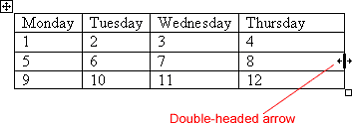
 To automatically adjust the size, select the entire table and then choose Table
To automatically adjust the size, select the entire table and then choose Table  AutoFit
AutoFit  AutoFit to Contents.
AutoFit to Contents.
AutoFormat
Just as Word offers document templates for memos, faxes, reports, and other items, it also offers templates for tables.
To use AutoFormat:
- Create your table.
- Click anywhere in the table. Go to the toolbar and select Table and then Table AutoFormat. The Table AutoFormat dialog box appears.
- Scroll through the Table Styles until you find a table you like. You can preview each table style in the Preview box.
- Check and uncheck the options in the Apply special Formats to: sections to slightly change parts of your table. Check out your changes using the Preview box.
- Click the New button to customize your own table style.
- Click the Modify button to change parts of an existing table style.
- Click OK.
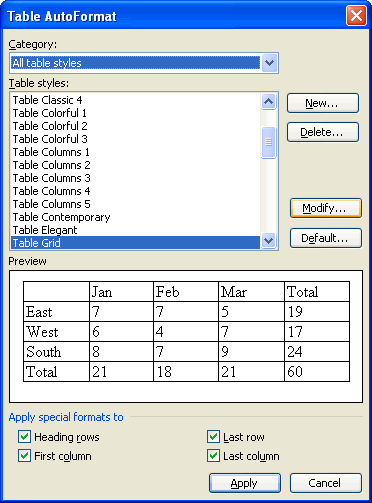
Adding borders
Many of the tables in the AutoFormat dialog box use unique borders and shading options. To add these special features to your own table, you can use the Tables and Borders toolbar.
To change line style or line weight on an existing table:
- Click the drop-down arrows (next to the buttons) to view and select from the list of choices.
- The mouse pointer turns into a pencil
 .
. - Trace the line(s) you want to change.
- Click anywhere outside the table to change to pencil back into the I-beam.
To change the border color on an existing table:
- Click the drop-down arrow next to the Border Color button. A color menu appears.
- Select a color. The I-beam becomes the pencil.
- Using the pencil, trace the border(s) you want to color.
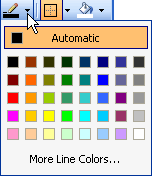
To apply a border:
- Select the line style, line weight, and border color you would like.
- Select the cells you want bordered.
- Click the Outside Border button drop-down menu, and choose the location of your border.

Adding shading
To apply shading:
- Select or place the insertion point inside the cell(s) you want shaded.
- Click the Shading Color button drop-down arrow. A shading color menu appears.
- Click on a color. Your cell(s) are automatically shaded.
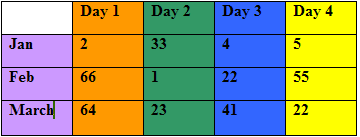
Did you know?
You can access many of the features from the Table and Borders dialog box on the task pane. Choose the Reveal Formatting Menu and look for the Table and Cell Headings.
Challenge!
- Open your document.
- Edit the text, if necessary. Ask yourself:
- Is it the right font and size?
- What direction do I want the text?
- How do I want it aligned?
- Delete any unnecessary rows or columns.
- Add any needed rows or columns.
- Resize the table if needed.
- Modify the color and thickness of the lines if needed.
- Apply shading to the table if needed.
- Save and close the document.
/en/word2003/working-with-objects/content/


 : on the Tables and Borders toolbar.
: on the Tables and Borders toolbar.
 The insertion point rotates when entering vertical text, but editing vertical text is no different from editing horizontal text.
The insertion point rotates when entering vertical text, but editing vertical text is no different from editing horizontal text. Insert
Insert  Rows above OR Rows below.
Rows above OR Rows below. Delete
Delete  Rows.
Rows. Delete
Delete  Rows from the shortcut menu.
Rows from the shortcut menu. Delete
Delete  Cells from the menu bar. The Delete Cells dialog box appears.
Cells from the menu bar. The Delete Cells dialog box appears.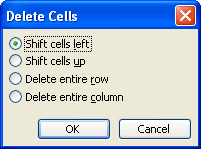
 Insert
Insert  Insert Columns to the Right or Insert Columns to the Left.
Insert Columns to the Right or Insert Columns to the Left.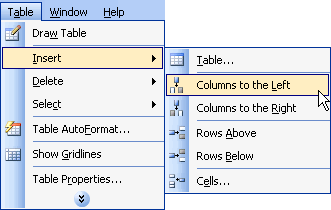

 To automatically adjust the size, select the entire table and then choose Table
To automatically adjust the size, select the entire table and then choose Table  AutoFit
AutoFit  AutoFit to Contents.
AutoFit to Contents.


